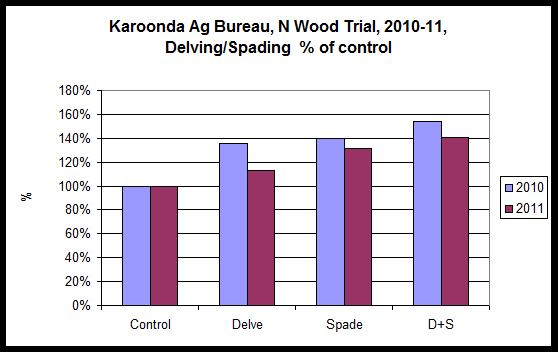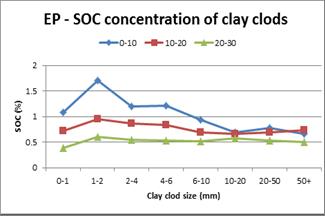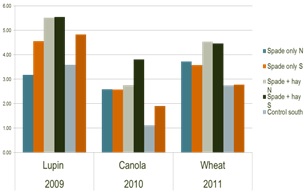Increasing agricultural production by alleviating soil constraints in South Australia
Increasing agricultural production by alleviating soil constraints in South Australia
Author: David Davenport | Date: 25 Feb 2014
David Davenport,
PIRSA, Rural Solutions SA.
Take home messages
- About 40 per cent of the area under broadacre agriculture in South Australia has issues that limit soil productivity.
- Improving the texture and nutritional status of infertile water repellent sands, and the soil structure in heavier soils, provides a great opportunity to increase broadacre production.
- The potential to increase food production, through implementing available technologies addressing soil constraints across South Australia, is worth around $600 million per annum.
- The 'New Horizons' initiative has been developed by PIRSA to fast track the benefits to community and the economy.
Introduction
There are around 10.7 million ha of land under broadacre agriculture in South Australia. Production on about 40 per cent of this area (4.1 million ha) is severely limited by soil issues, which can be addressed through soil modification. The greatest opportunities appears to be in radically improving the texture and nutritional status of infertile water repellent sands (2.8 million ha) and improving soil structure in heavier soils with sodic and or poorly structured clay sub-soils (1.7 million ha).
Previous trials and demonstrations funded through the Department of Environment Water and Natural Resources (DEWNR) and Caring for Our Country have shown large increases in production are possible, however results have been variable and somewhat unpredictable. 'New Horizons' is a pilot programme to determine the causal relationships; the practicality of amelioration; the potential production benefit; and what is required to realise this benefit.
This document provides a summary of areas of potential opportunity and also a brief description of the most likely and most beneficial outcomes.
Indicators of soil health and water use efficiency
Soil organic carbon (SOC) is one of four indicators of soil condition identified in the national land and water audit. SOC levels are largely determined by the amount of input of carbon (often related to rainfall, but also to water use efficiency (WUE)) and the clay percentage. Analysis conducted by DEWNR of soil data from the State Land and Soil Information Framework (SL&SIF) has identified that, while there is large variability in SOC within rainfall and soil texture categories, there are correlations with soil texture and structure, particularly in subsoils.
Analysis of production data conducted by McCord and Payne in the 1990s identified that much of the agricultural area of South Australia delivers yields in the range of 40 to 70 per cent of the French Shultz potential. Therefore, there is a large untapped opportunity to increase yields on these soils.
Major areas of opportunity
Analysis conducted by DEWNR and PIRSA has identified that the largest area for potential gain through soil modification are as follows.
Sandy soils
There are around 2.8 million ha of sand and loamy sand soils under agricultural production in South Australia. Production on these soils often achieves only 40 to 60 per cent water use efficiency. These soils are low in organic carbon, can be non-wetting and have low nutrient and water holding capacity.
A large proportion of these soils have very infertile, bleached, A2 horizons. Root systems in the A2 horizon are often weak and diminish rapidly with depth, rarely penetrating to the B horizon below. This would severely restrict nutrient and water uptake by crops and pastures. The cost of foregone production on these soils has been estimated at around $760 million per annum (DEWNR 2004). There are also additional costs resulting from increased wind erosion potential and difficulties in weed control.
Options to address issues on sandy soils are outlined below.
Clay addition
The addition of clay to these soils was first undertaken almost 40 years ago by Clem Obst, a farmer in the south east of South Australia. Since then there has been broad uptake of the technique, however results have been mixed. While a review of claying trials in South Australia showed an average yield increase of 70 per cent, individual results ranged from 0 to 100 per cent. A typical example is detailed in Figure 1. This practice requires a large investment by farmers and the lack of consistent results has constrained uptake and the potential production gains that can be obtained.

Figure 1. Karoonda clay trials (Tonkin 2012).
Deep nutrition and the addition of organic matter
Research conducted at Wharminda by Doudle et al (2004) has shown that yields can be increased by up to 100 per cent through the addition of deep nutrients to these soils. Trials using combinations of nutrients banded at different depths to 80 cm identified that the placement of major nutrients (N, P and trace elements) to 40 cm delivered the best results. More recently Masters and Davenport (2012) have shown that deep incorporation of organic matter can also deliver substantial yield increases in both clayed and un-clayed sands.
Questions and answers
Analysis of 60 clayed and un-clayed sites (Schapel and Davenport unpublished) suggests that the best results are obtained where sufficient clay is added to overcome non-wetting in the topsoil and allow clay incorporation into the bleached A2 horizon. Schapel (2012) has also identified that SOC stocks (0 to 30 cm) can be doubled where appropriate modification practice is applied. This not only supports increased productivity but also provides the opportunity for a large emission offset (70 to 75 t/ha CO2e).
Although there is understanding of the constraints, the most effective and economical treatments are yet to be confirmed. Questions include those outlined below.
Clay distribution.
The distribution of clay is also a factor with clay clod size appearing to affect both root distribution and organic carbon content. Schapel (unpublished) has identified that there is a relationship between clay clod size and organic carbon concentration of the clod (Figure 2). One study has also suggested that roots are attracted to small clay clods rather than large clods.

Figure 2. Relationship of sand and clay clod size to SOC.
The role of added organic matter.
Demonstrations have identified that the addition of organic matter has delivered increased yields and higher soil organic carbon levels, with one site on Eyre Peninsula showing increased yields for at least 3 years (Figure 3). This trial details yield data (t/ha) from 2 sets of treatments (N=North and S=South) on a shallow sand over clay site spaded in 2009. Analysis of a site on Eyre Peninsula, and one in the south east, has identified that the root mass of the 10 to 30 cm layer can be doubled through claying and tripled with the addition of clay and organic matter, thereby enabling greater nutrient and water uptake.

Figure 3. Edillilie trial data.
Deep nutrition.
The length of the benefit; different combinations of nutrients; and whether the production gains can be enhanced by coupling with added ameliorants, such as clay and organic matter, need to be confirmed. As not all soils need a full range of nutrition treatments, development of a 'least cost package' determining the nutrition requirements to 40 cm for individual soils would be a major development.
Sandy loam and heavier soils with sodic, poorly structured or bleached horizons
Similar to sands these soils have constraints impacting on root development and also have low SOC levels in subsoil horizons. However, there has been very little research in South Australia conducted on the factors causing these issues on these soil types.
Data collected from red brown earths in the national Soil Carbon and Research Program (SCaRP) recorded soil carbon stocks to 30 cm ranging from 13 t/ha to 72 t/ha. There is a poor correlation between bulk density and carbon except where bulk density exceeds 1.6 g/cm3. Where bulk density exceeds this level anywhere in 0 to 30 cm, low carbon stocks are found.
In the past, deep ripping has been used at various times to address poor structure, however, results have been mixed and benefits have generally been short term. This could be expected as without addressing sodicity (by the addition of gypsum) or the poor structure of highly weathered clays (by the addition of organic material and or calcium) to the affected depth, the cause of poor structure will not be ameliorated.
The lack of suitability of equipment to deliver amendments deep into these soils has been a constraint to adoption. The development and availability of equipment such as the DRS plough that combines deep ripping with the incorporation of ameliorants to 20 cm now makes this practical on a broadacre basis. Further development is needed in this area to determine the form, amount and depth of incorporation of amendments to deliver the most practical and economic benefits.
New horizons
'New Horizons' is an initiative to capture the potential of an additional $600 million increase in food production per annum in South Australia; increase long-term storage of carbon; and obtain a significant reduction in soil erosion risk.
This program will focus on soils under broadacre agriculture in this state. Specifically, soil issues limiting agricultural production that can be addressed with innovations in soil amelioration and crop husbandry.
An adaptive management design model for the research and extension program will follow a cycle of design, implementation, monitoring, evaluation, communication and review. PIRSA is currently exploring opportunities to deliver this major strategic initiative and is currently talking to potential partners. Given the size of the opportunity and the long term benefit New Horizons can provide, support from grower organisations is vital to ensure the maximum benefit is achieved.
Conclusion
Analysis of the potential for uptake and economics conducted by PIRSA suggests that the potential to increase food production, through implementing available technologies addressing soil constraints across the state, is around $600 million per annum. This increase is generated by an increase in production from higher crop yields and also increases in pasture growth supporting higher stock numbers per area. The figure also accounts for some expected shifts from pasture to higher value cropping as a result of the improvements in soil fertility. Adoption modelling suggests that measurable increases in food production will occur after three to four years from the start of the program.
The program will also deliver significant environmental gains. There will be reductions in erosion risk and recharge to saline water tables over a large proportion of the agricultural area. Research has also demonstrated that increases in long-term storage of soil carbon following soil modification can occur. This could realise an emissions offset exceeding 200 mega tonnes (Mt) of CO2e compared with South Australia’s total current annual net emissions of approximately 30 Mt.
References
Doudle S, Wilhelm N, ‘Subsoil Nutrition, 2003 Results’‘ Eyre Peninsula Farming Systems Summary 203, EPARF PP 109-115.
Masters B (unpublished) Deep incorporation of organic matter to improve crop production on modified duplex sandy soils. Land Management Consultant, Rural Solutions SA ‘Addressing production constraints through the modification of sandy soils’ Eyre Peninsula Farming Systems Summary 2011, EPARF PP 166-172.
Schapel, A, Davenport. D, Grant, C and Marschner, P. (2012). Evaluation of an accurate sampling methodology for determining soil organic carbon in clay delved sandy texture-contrast soils. Presented Poster, Soil Solutions for Diverse Landscapes, Joint SSA and NZSSS Soil Science Conference, 2-7 December 2012, Hobart.
Tonkin (2012) “Soil Modification effects on clay, CEC and organic carbon content using delving and spading on a sandy texture-contrast soil in the South Australian Mallee” Draft paper for the Soil Science Australia National Conference Dec 2012.
Contact details
David Davenport
08 8688 3404
